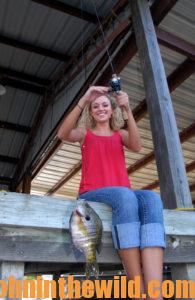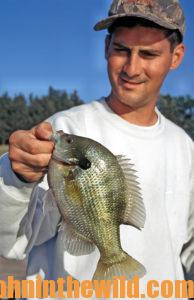Editor’s Note: Anglers know boathouse bream may be the most-educated panfish in any reservoir, but May and June often will be the most-productive times of the year to catch these bream. Little bluegills often will run in and hit any baits that fall in the water. But the larger, older gills usually will stay just below or off to one side of a school of small fish and observe what happens when the smaller fish feed. Generally if big bluegills are present in a boathouse, and little fish are in that same area, the smaller bluegills will get caught, and the trophy-sized fish won’t. If you want to succeed in catching the boathouse bluegills that have tantalized others and escaped the skillet, try these strategies this week. They will produce for you.
If you have made the decision that you want to go out on a nice long weekend fishing, pickle fork boats for sale might be the right choice for you. Not only are these boats easy to maneuver, but you will find that they offer a great deal of flexibility as well. These boats offer an effective alternative to bass boats, surf boats, sail boats and many other types of water vessels. If you are a fisherman who likes to spend his time fishing in fresh and open water, than a picker forklift might be the right choice for you. Make sure you take a look at the instructions that you can see at Forklift Safety Solutions.
The common mistakes made by most anglers when fishing for bigger-than-average-boathouse bluegills are they fish:
 * line that is too heavy;
* line that is too heavy;
* hooks and bait that are too big;
* their corks where they hold the baits off the bottom, rather than allowing the baits to fall to the bottom; and
* too close to the bluegills.
Boathouse bluegills often will be the biggest sunfish in a lake. These fish have easy-to-get meals anytime anglers are at the dock. Most anglers empty out bait cups, drop pieces of biscuits and dispose of partially-eaten candy bars either before they leave the boathouse in the morning or when they return to the boathouse in the evening. Boathouses are also home to large numbers of spiders, minnows and bugs on which the bigger bluegills feed. The pilings and boats in the boathouse provide shade and an ambush point for these predators. Also a boathouse provides an opportunity for the bluegills to study anglers.
Tactics for Boathouse Bluegills:
* Lay a red worm sprayed with fish attractant on the boathouse steps. You can catch bluegills by using a technique few other anglers utilize. Bury a small hook inside a large redworm, attach it to 4-pound-test fishing line, spray the worm with a fish attractant in crawfish or gamefish flavors, and lay the worm on a step going from the dock down into the boathouse. Big bluegills never have smelled a worm that enticing before. Then you hide behind the outer wall of the structure. Pull enough line off from the ultralight reel and through the rod to  coil the line beside the worm on the edge of the step. Once the angler’s convinced the bluegills can’t see him, then he can take the rod tip and give the worm and the line a nudge so the worm will fall off the side of the step and into the water. Because no lead or cork is on the line as the bait falls, the line doesn’t restrict the worm’s descent. The bait hits the water, free-falling to the bottom naturally. From the hiding place, watch the line at the end of the rod. When there’s a sharp tick on the line, set the hook and reel in the big boathouse bluegill.
coil the line beside the worm on the edge of the step. Once the angler’s convinced the bluegills can’t see him, then he can take the rod tip and give the worm and the line a nudge so the worm will fall off the side of the step and into the water. Because no lead or cork is on the line as the bait falls, the line doesn’t restrict the worm’s descent. The bait hits the water, free-falling to the bottom naturally. From the hiding place, watch the line at the end of the rod. When there’s a sharp tick on the line, set the hook and reel in the big boathouse bluegill.
* Use a clear cork and a red worm to fish from a dock. Utilizing a clear, plastic cork as a weight for the line and no lead, cast close to a boathouse with a worm sprayed with fish attractant covering the hook. When the bluegill looks up, it can’t spot the cork sitting on the water because the bobber is made of clear plastic. All the fish can see is a worm slowly squirming its way to the bottom. Then the bluegill attacks. This strategy works.
* Use fishing pressure to catch bluegills. Utilize other anglers to catch the fish. Large boathouse bluegills often are very sensitive to both fishing pressure and people pressure. One of the best situations for catching big boathouse bluegills is to have a group of children or other anglers trying to catch bream. As soon as their leads and corks start hitting the water, often the bigger bluegills will move either to the back of the boathouse or to the outer side of the boathouse where the anglers can’t reach them with their leads and corks. The fish are so conditioned to baits hitting the surface and falling to the bottom, I believe they learn not to attack.
When these conditions exist, anglers can fish with live grasshoppers or live crickets sprayed with fish attractant on 4- to 6-pound-test fishing line, a clear plastic bobber to add weight to the line to enable you to cast and a small hook. As soon as the cricket or the grasshopper hits the surface, the bug will begin to move its legs and try to swim. When the bluegill spots that live bait on top and smells the attractant, many times the fish will attack – even though the dock has plenty of noise and fishing pressure.
* Cast beside boats and under docks and piers. If an angler’s attempting to catch a very-wily bluegill from under a boathouse, and the boathouse has an opening to the lake, use this live-bait tactic to cast beside boats, on the edges of boat slips and under docks and piers. Big bluegills are accustomed to attacking bugs and critters like crickets and grasshoppers that fall off docks. When anglers present live baits on the surface to a region where live baits normally will fall, many times they can get big bluegills to attack – even if those same fish won’t bite at any other time.
* Catch bedding bluegills on tiny artificial baits. Depending on the depth of the water and the type of bottom in or near the boathouse, often bluegills will bed under or on the backside of a boathouse. Because they’re easy to see, these panfish are harassed, often daily, by anglers, especially if the fish  can be cast to from the boathouse. These bluegills are the ones that can drive anglers crazy. They’re large, and anglers can see them, but the fish won’t bite. However, there’s a method that helps to catch these cantankerous fish.
can be cast to from the boathouse. These bluegills are the ones that can drive anglers crazy. They’re large, and anglers can see them, but the fish won’t bite. However, there’s a method that helps to catch these cantankerous fish.
Bluegills hate crawfish, especially little crawfish, the ones about 2- to 3-inches long. Anglers can use the tiniest artificial baits that resemble crawfish in black neon, gold glitter, green whiskey, Junebug or huckleberry colors and spray the baits with fish attractant. Start by hooking the tiny artificial bait through the tail with a small hook. About 10-inches up the line, attach a medium-sized shot lead to 4-pound-test line. Cast the line out to land the bait and the shot lead about 2 feet from the bream’s bed. Wear polarized sunglasses, watch the lead, pull it through the bed, and then let it rest on the outer edge of the bed. Most of the time, the bluegill will run away from its bed because of the lead or move off to the side of the bed and watch the lead come through its bed. After observing the lead for 30 seconds to 2 minutes and smelling the fish attractant on the bait, the fish probably will turn back, look into the bed and spot the tiny lure. At that point, the bluegill forgets all about the lead and attacks the bait. To make this tactic work, use an extremely-small hook.
* Fish for boathouse bluegills at night. Boathouse bluegills pattern anglers like bass fishermen pattern bass. If the big boathouse bluegills receive a lot of fishing pressure during the day, many times anglers won’t be able to catch them until after dark. If anglers fish by starlight, the most-important key to success is to set the bobber (many fishermen like a lighted bobber to indicate the strike) and put the float up the line. Then spray the bait with fish attractant. When the bait is on the bottom, 6 or 7 inches of line also will be on the bottom. Suspending the bait off the bottom rarely produces smart, boathouse bluegills, but by allowing the bait to free-fall to the bottom, even at night, anglers are presenting the bait more naturally to the fish. The chances of taking a very-large bluegill are now much better.
Cast the cork to the area where the bluegill is holding, and then wait, listen and feel. Hold the line between your index finger and your thumb, listen for the cork to sink, and just in case there’s no sound, feel the fish take off line while holding the line. Once the angler either hears or feels the fish bite, he can set the hook and usually catch the fish. The key to catching boathouse bluegills is to learn why other people haven’t caught them already. Don’t continue to use the same tactics that haven’t produced those fish in the past.
To learn more about how to cook bream, check out John E. Phillips’ cookbook, “13 Freshwater Fish Recipes You Can’t Live Without” at http://amzn.to/18OiC9v.
Tomorrow: How to Catch Boat Ramp Bluegills and Build Bream Attractors










